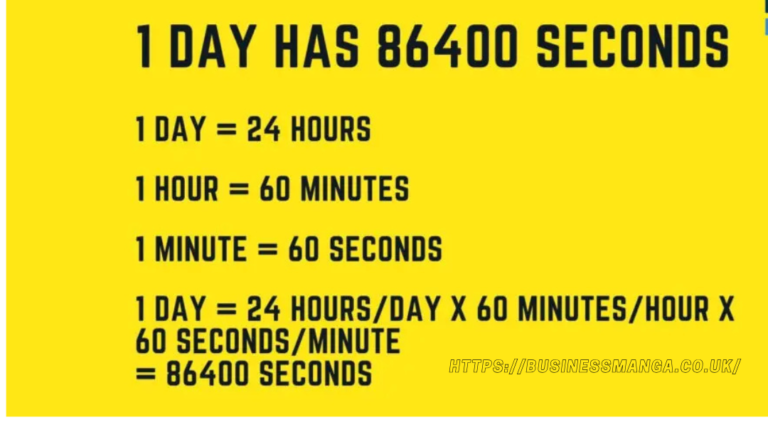In a fast-paced world, where every millisecond counts, understanding time conversions can give you an edge, especially in competitive exams where quick calculations are essential. One such fundamental conversion is knowing how many seconds are in a day. While the standard 24-hour day contains 86,400 seconds, the significance of this figure goes beyond simple curiosity—it is crucial for solving problems related to speed, time, and distance in a matter of seconds.
In this article, we will break down the concept of seconds in a day, derive the value of 86,400 seconds, and explain its applications. We will also provide quick tips and practice problems to help you ace this conversion in competitive exams.
How Many Seconds Are There in a 24-Hour Day?
To put it simply, a day is defined as the time it takes for the Earth to complete one full rotation on its axis. While technically, this rotation takes 23 hours, 56 minutes, and 4.1 seconds (about 86,164.1 seconds), for practical purposes, we use the mean solar day, which is adjusted to a full 24 hours or 86,400 seconds.
The Derivation of 86,400 Seconds
Let’s break this down step by step:
- 1 minute = 60 seconds
- 1 hour = 60 minutes, so 1 hour = 60×60=3,60060 \times 60 = 3,60060×60=3,600 seconds.
- 1 day = 24 hours, so 1 day = 24×3,600=86,40024 \times 3,600 = 86,40024×3,600=86,400 seconds.
Thus, there are 86,400 seconds in a full day.
Why Does This Matter?
Knowing how to quickly convert between time units—seconds, minutes, hours, and days—is essential in both academic and real-world scenarios. When solving problems that involve speed, time, and distance, you will need to convert units rapidly to avoid wasting time.
Understanding time conversions allows you to make faster decisions, especially when time is a critical factor.
Useful Time Conversion Factors
| Unit | Equivalent in Seconds |
|---|---|
| 1 Minute | 60 seconds |
| 1 Hour | 3,600 seconds |
| 1 Day | 86,400 seconds |
| 1 Week | 604,800 seconds (7 days) |
| 1 Year | 31,536,000 seconds (365 days) |
These conversions are not just numbers to remember but tools for quicker problem-solving in competitive exams.
Quick Conversion Thumb Rule
When converting between different time units:
- From a larger unit to a smaller unit, use multiplication.
- From a smaller unit to a larger unit, use division.
This rule simplifies complex conversions, whether you’re calculating seconds in a day or minutes in an hour.
Real-World Applications of Seconds in a Day
To see the importance of converting seconds in action, let’s go through some practical examples.
Example 1: Covering Distance Over Time
You are asked to calculate the number of seconds it takes to cover 200 km, knowing that it took 2.5 days to cover 100 km.
- If it takes 2.5 days to cover 100 km, then 200 km would take 5 days.
- Since 1 day = 86,400 seconds, we calculate: 5×86,400=432,000 seconds5 \times 86,400 = 432,000 \text{ seconds}5×86,400=432,000 seconds Therefore, it takes 432,000 seconds to cover the given distance.
Example 2: Minutes in a Day
You might be asked, “How many minutes are in a 24-hour day?” To solve:
- 1 day = 86,400 seconds, and since 1 minute = 60 seconds, divide: 86,400÷60=1,440 minutes86,400 \div 60 = 1,440 \text{ minutes}86,400÷60=1,440 minutes Hence, there are 1,440 minutes in a 24-hour day.
Example 3: Seconds in a Year
Let’s calculate the number of seconds in a solar year.
- Knowing that 1 year = 365 days and 1 day = 86,400 seconds, we find: 365×86,400=31,536,000 seconds365 \times 86,400 = 31,536,000 \text{ seconds}365×86,400=31,536,000 seconds Therefore, there are 31,536,000 seconds in a year.
Practical Tips for Competitive Exams
- Familiarize yourself with basic time conversions like seconds in a minute, hour, and day.
- Practice quick calculations to ensure you can solve time, speed, and distance problems within seconds.
- Use unitary methods and shortcut formulas to make your calculations more efficient.
Commonly Asked Questions
Q: How many seconds are in 12 hours?
A: Since 1 hour = 3,600 seconds, 12 hours = 12×3,600=43,20012 \times 3,600 = 43,20012×3,600=43,200 seconds.
Q: What is the number of milliseconds in a day?
A: 1 second = 1,000 milliseconds, so 86,400×1,000=86,400,00086,400 \times 1,000 = 86,400,00086,400×1,000=86,400,000 milliseconds in a day.
Q: How many seconds are in a leap year?
A: A leap year has 366 days. So, 366×86,400=31,622,400366 \times 86,400 = 31,622,400366×86,400=31,622,400 seconds in a leap year.
Conclusion
There are 86,400 seconds in a standard 24-hour day, and knowing this fundamental fact can streamline your approach to various problems in competitive exams. From simple time conversions to complex problems involving speed and distance, mastering this knowledge will not only save you time but give you an advantage in scoring high.
With consistent practice, you’ll be able to calculate the number of seconds, minutes, or hours required for any situation in seconds—no pun intended!
Now that you’ve got a solid grasp on time conversions, take your preparation further by learning more about Speed, Time, and Distance through the Testbook app. Get started today and ace your exams with confidence!
